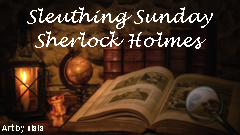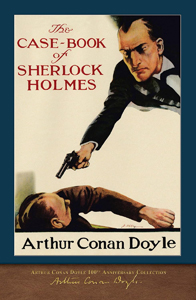Arthur Conan Doyle writes his last dozen Holmes stories from 1921-27, collected in “The Case-Book of Sherlock Holmes” (1927), as if knowing they will be his last chance to try new things. In addition to nine narrated, as usual, by Watson, he includes two stories narrated by Holmes and one with a third-person omniscient narrator.
That’s the standard approach to a narrative, but it seems weird for a Holmes story because we’re so accustomed to the homey first-person narration. For that reason, and also because it’s not a great plot, “The Adventure of the Mazarin Stone” is weak. The other third-person Holmes story, “His Last Bow” (from the previous collection), is likewise not a high point.
Holmes meets horror
But there end the weak points. In terms of topics, “Case-Book” gets notably spookier, which I love. Doyle flirts with the idea of a vampire, a werewolf and a sea creature, but stays on the scientific side of the line – or perhaps science fiction, but not quite the supernatural.

“The Case-Book of Sherlock Holmes” (1927)
Author: Arthur Conan Doyle
Series: “Sherlock Holmes” No. 9 (the fifth short-story collection)
Genre: Detective mystery short stories
Setting: Throughout Holmes’ career, mostly in England
In “The Adventure of the Sussex Vampire,” a woman seems to be a vampire, having bitten her baby on the neck. Since actual vampirism is never truly in play in the grounded world of Holmes, it’s fascinating to discover the true reason for her behavior.
“The Adventure of the Creeping Man” doesn’t directly reference werewolf lore, but I noticed the parallels, as a man acts strange at a set interval of days, walking hunched over in the middle of the night. “The Adventure of the Blanched Soldier” (narrated by Holmes) likewise features a man behaving strangely, and it has an added layer of mystery: His relatives are keeping him hidden after initially claiming he is on a long vacation.
The other Holmes-narrated piece, “The Adventure of the Lion’s Mane,” is a wild one, as a heavily lacerated body is found on the beach, near the home Sherlock has taken for peace and quiet now that he’s done with the bustle of London and his career. This might be Doyle’s last chronological story, so it’s crazy that it centers on a bizarre discovery in the animal kingdom, not a common topic in the canon.
“Case-Book’s” horror elements also include facial disfiguration, which plays into the conclusion of “The Adventure of the Illustrious Client,” a heavily psychological piece. Holmes must convince a smitten lover of a horrible man that this man is not worth her devotion. These themes are even more central to “The Adventure of the Veiled Lodger,” about a disfigured woman who was mauled by a lion. But in a reverse of “Client,” she hates her former lover.
Bodies, bodies, bodies
The secret disposing of a body is another gothic element, used to fine effect in “The Adventure of Shoscombe Old Place,” one of those tales where Holmes makes his own moral judgment rather than handing off a culprit to the police. It has an unusually Pollyana result for the sympathetic criminal, considering the darkness of this volume.

“The Adventure of the Retired Colourman” likewise centers on the disappearance of people – or perhaps their murder and the hiding of their bodies – but with a less sympathetic client.
“The Problem of Thor Bridge” features that classic structure wherein there’s only one obvious suspect – and thus the inflexible British justice system intends to execute her. However, she is innocent and Holmes must race against time to prove what really happened. That a frame-job is the answer is no big twist, but the identity of the framer is unusual.
“Case-Book” has a couple good pieces shorter on horror and violence. “The Adventure of the Three Gables” is built on a mystery that a reader has fair chance of solving, at least broadly: A woman is randomly offered an incredible price for her home, on the condition that all its contents are part of the sale, too. What particular object is so valuable, we wonder.
Speaking of titles about trios, “The Adventure of the Three Garridebs” likewise invites us to mull the motive behind a bizarre offer that seems to good to be true. A man surnamed Garrideb finds another man by that name and claims if they can find a third, they will all by rich, as per the will of an American by that name.
Final thoughts on Doyle’s Sherlock canon
Rather than limping to the finish line of his Holmes catalog of 56 short stories and four novels, Doyle is re-energized, perhaps by the gothic horror topics and how he plays with point-of-view. So much so that there was once a conspiracy theory that Doyle didn’t write “Case-Book’s” stories!
But what most surprises me at the end of my Holmes journey is that Doyle was never interested in continuity. In most tales, Watson flashes back to an old case that he’s declassifying for the reader, using Holmes’ files to refresh his memory. And presumably those files include verbatim quotes; otherwise, Watson’s memory recall is supernatural. If so, the heavy use of direct quotation (including quotes-within-quotes, as a speaker recounts a speech) is one of those fictional conceits we allow.
Having completed the Holmes canon, it’s rather shocking that Moriarty is not an ever-present villain (he only appears in “The Final Problem”); his rise to that status must be attributed to the screen adaptations. Nor is Irene Adler a significant love interest (she only appears in “A Scandal in Bohemia”). It’s amusing to learn that Sherlock has an equally ingenious brother, Mycroft, who enjoys his leisure time too much to bother solving cases. (He appears in three stories, making him a more important supporting player than Moriarty and Adler.)
Another discovery is that Doyle doesn’t go full-bore into puzzle mysteries, where the reader can play along (if they desire) by tallying and sorting clues. He skirts the edge, in that we might correctly guess what happened, but it’s rarely because he has laid out a string of clues. Rather, we draw from typical human behavior and likelihoods in the machinations of society to make sense of the nonsensical.
As he hands of the master-of-mysteries moniker to Agatha Christie in the 1920s, he’ll leave it to her to pioneer the play-along format. But he also leaves quite a gift by popularizing and codifying the trope of an individualist genius who has one close friend to use as a sounding board (and liaison to the reader).
Sleuthing Sunday reviews the works of Agatha Christie, along with other new and old classics of the mystery genre.

